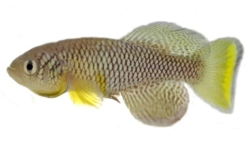| Turquoise killifish | |
|---|---|
 | |
| Male Nothobranchius furzeri GRZ (from Gonarezhou National Park) | |
| Scientific classification | |
| Kingdom: | Animalia |
| Phylum: | Chordata |
| Class: | Actinopterygii |
| Order: | Cyprinodontiformes |
| Family: | Nothobranchiidae |
| Genus: | Nothobranchius |
| Species: | N. furzeri |
| Binomial name | |
| Nothobranchius furzeri R. A. Jubb, 1971 | |
Nothobranchius furzeri, the turquoise killifish, is a species of killifish from the family Nothobranchiidae native to Africa where it is only known from Zimbabwe and Mozambique. [2] This annual killifish inhabits ephemeral pools in semi-arid areas with scarce and erratic precipitations and have adapted to the routine drying of their environment by evolving desiccation-resistant eggs that can remain dormant in the dry mud for one and maybe more years by entering into diapause. [3]
Among vertebrates, the species has the fastest known sexual maturity – only 14 days after hatching. [4] [5] Due to very short duration of the rain season, the natural lifespan of these animals is limited to a few months [6] [7] and their captive lifespan is likewise short. More specifically, they are able to live 1–5 months in the wild (with most only living up to 2 months [7] ) and 3 [8] to 16 [9] months in captivity depending on the strain and environment. Turquoise killifish are the shortest-lived vertebrate kept in captivity [10] making them an attractive model system for ageing and disease research. [11] Tandem repeats comprise 21% of the species' genome, an abnormally high proportion, which has been suggested as a factor in its fast ageing. [12] [13] Their captive diet consists mostly bloodworms and there are current efforts to replace bloodworms by pelleted diets. [14]
This species can reach a total length of 6.5 cm (2.6 in). [2]
The species name is derived from that of the discoverer Richard E. Furzer of Rhodesia. [15]
